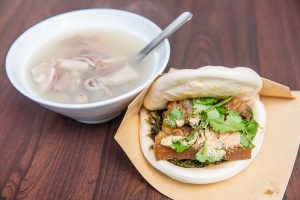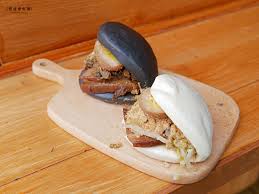Gua bao




Gua bao (Chinese: 割包 or 刈包; pinyin: guàbāo; Pe̍h-ōe-jī: koah-pau; lit. ‘cut bread’)
It consists of a slice of stewed meat and condiments sandwiched between flat steamed bread known as lotus leaf bread. The lotus leaf bun is typically 6–8 centimetres (2.4–3.1 in) in size, semi-circular and flat in form, with a horizontal fold that, when opened, gives the appearance that it has been sliced. The traditional filling for gua bao is a slice of red-cooked pork belly, typically dressed with stir-fried suan cai (pickled mustard greens), coriander, and ground peanuts.
The gua bao originated from the coastal regions of Fujian province in China. It is said to have come from either the cities of Quanzhou or Fuzhou. In Quanzhou, gua bao is known as rou jia bao (meat between buns) or hu yao shi (tiger bites lion). The custom of Hui’an people in Quanzhou is to eat these pork belly buns to celebrate the marrying off of a daughter.[12] In Jinjiang, a county of Quanzhou, there is a related vegetarian dish known as hu yao cao 虎咬草 (tiger bites grass) that replaces the pork with a solidified peanut paste and the lotus leaf bread with a bread that is baked in a clay oven similar to a tandoor.
In Taiwan, gua bao were said to be introduced to the island by Fuzhounese immigrants. The food is known colloquially in parts of Taiwan as hó͘-kā-ti (虎咬豬; ‘tiger bites pig’) in Taiwanese Hokkien due to the mouth-like form of the bun and the contents of the filling.


